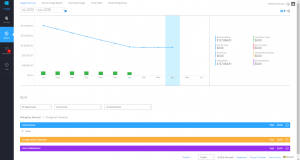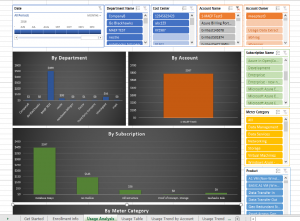Where can I find my Azure Billing Reports?
This blog post is for organizations that have licensed Azure through an Enterprise Program (EP) such as Microsoft Enterprise Agreement. Licensing Azure through EP provides access to the Azure Enterprise Portal and the Azure Billing API.
Access your bill –> Azure provides consumption and billing breakdown under the reports tab on the Enterprise portal [https://ea.azure.com/]. You can further browse the tabs at the top (1) Usage Summary (2) Service Usage Report, (3) Download Usage, (4) Price Sheet and (5) Power BI reporting for more specific details on your Azure consumption bill.
Understanding your bill –> Azure documentation provides a comprehensive explanation on the specific aspects of your bill providing that initial understanding of cost breakdowns, definitions as you onboard Microsoft Azure.
What if I do not see the individual line items on my bill at the Azure portal?
Please ensure your re-seller has entered your institution’s “markup” details into the portal. This is required since it ensures that your portal accurately reflects Re-seller provided pricing and going forward will help you estimate the cost as you procure new Azure services/VMs. At times, when EA subscription is first established re-sellers may not have set this up, however, it can be updated later.
What if I need more information and need to analyze my consumption?
Azure provides 2 distinct REST based APIs – RateCard and Usage. Azure Usage API let customers and partners retrieve subscription usage data (including the resource tags set by the customer). Azure RateCard API provides a complete list of resources and their respective rates for an Azure offer code level (PAYG, EA, MSDN etc.) These APIs have been harnessed by a number of Azure marketplace providers to offer sophisticated dashboards for your EA subscription (a few listed below as we evaluated them, recently). Most of these offerings include a top-down consumption chart from Enterprise –> Account –> Subscriptions levels with pivots for Azure consumption by Service types, Tags created and several other attributes of interest.
Hanuinsight [https://www.hanuinsight.com/]
More information on Enterprise IT chargeback here (with screenshots) and pricing tiers here. While the standard tier is free after you subscribe from market place and spin a new VM (no creating a new VM is not free, but you may run the VM only while running the report and stop afterwards to limit the VM charge). Professional edition offers several other features regarding notification, alerting, publishing reports (more push based mechanisms of reporting/alerting).
Azure Costs [https://azure-costs.com/]
You can sign in using your Microsoft Id (Hotmail, outlook etc.) and provide the access key, it syncs up and produces the below dashboard within 2-3 minutes (I personally found it quite easy to get started). Once on the dashboard, you can pivot the spending by Subscriptions, Tags, Service Types, Resource Groups, Cost Center and Departments. The dashboard has several graphs on daily, weekly burn rates et al (including CSV downloads). Starts with a 14 day trial (absolutely free). Basic tier is free but allows only 2 rolling months of data retention while other offerings are $29, $79 and $199 per month.
Cloudyn [https://www.cloudyn.com/microsoft-azure/]
Cloudyn is essentially an enterprise level IT Financial management (ITFM) solution (video link) and could be a great solution for large enterprise level accounts given the complexity of business, cross-charging, analytics and trending needs.
Cloud Cruiser [https://www.cloudcruiser.com/]
Yet another full suite ITFM solution, Cloud cruiser integration with Azure Ratecard and Usage API [documentation] takes billing/dash boarding to the next level. Cloud Cruiser allows for simulation and mock scenarios for upcoming projects and cost re-balancing exercises.
What if I don't wish to pay for additional insights into my billing?
While the Azure REST APIs can be easily harnessed using PowerShell or any programming language of choice (.NET, Java, Python) to produce CSV based extracts, linking multiple such extracts to generate dataset for analysis can be very challenging. Furthermore, this may well be a recurring exercise (for most of the IT spending and budget this could be periodical reporting). To alleviate some of these concerns, download and use this Excel based dashboard that extracts data for your EA subscription and let you custom create pivots and charts as required. Step by Step first-time setup and refresh instructions are described here. The dashboard needs one time entry of Enrollment number and the Access Key from your Azure portal (you can save the excel locally and customize it). Instructions to use (including “Refresh” my data) are included on the tab “Enterprise Enrollment”.
(Originally created by Ed Mondek (Microsoft, Cloud Architect) – blog site here (also includes same .NET code to generate a sample report)
Can I see a sample code so I can extend myself?
Of course, you can download Azure Billing code samples from GitHub repo here: https://github.com/Azure/BillingCodeSamples

